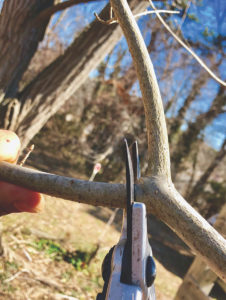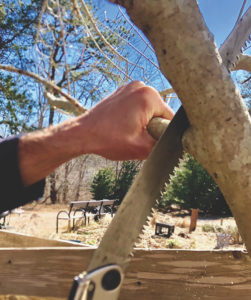
Hacking. Butchering. Murdering. These are all terms we hear when the subject of pruning comes up. These words betray a widely held belief that pruning is an act of brutality. Proper pruning is not. At its core, pruning is an act of rejuvenation. It is the intentional manipulation of plants to achieve an intended result. Pruning is a good thing. Get cozy with it.
Armed with a little information, you can walk out into your yard this spring, not as a figure of death, cloaked in dark robes, carrying your scythe, off to mangle some poor shrub. Instead, you’ll be a bearer of good fortune, removing the flaws of the woody plants that surround your home, encouraging beauty, and guiding your trees and shrubs toward optimum health.
As the ground warms and the spring rains begin to fall, plants begin to awaken. Their juices start to move again, bringing water and nutrients out from storage and into sleeping branches. Your job, as the pruner, is to decide where these resources will go. By selectively removing stems and branches, you are helping the plant direct its growth most effectively.
Mid to late March is a great time to get out and prune many of our plants. The great growth push of spring is about to happen. This means that stored resources will help pruning cuts to heal quickly and efficiently. And with trees and shrubs standing bare, you can see the structure of the plants and access the areas where pruning needs to be done.
Because I love overly indulgent metaphors, I’m going to explain the basic concept of pruning like this: Picture a tree. Now imagine the tree as a river. The river is flowing upward from the roots, up through the limbs, splitting off into smaller and smaller branches. Water and resources flow through this river, from roots to tips. When a branch is removed, you are redirecting the river’s flow.
And this brings us to the intention part. Pruning is done for a purpose. The cuts you make are chosen — to improve health, create strong structure, achieve a desired shape or look, or to encourage fruit and flower production.
A tree or shrub left to grow wild will do just fine. It doesn’t need you. It will flower and fruit and grow. But we prune to achieve something. Pruning is the interaction of a wild plant and a human mind.

When you set out to prune, your first step is to envision an outcome. From there, the reasons for your cuts will be clear. The way you will prune an apple tree to produce fruit is very different from the way you will prune a privet hedge to screen your nosy neighbor.
Some woody plants are better pruned after they flower, while others respond well to an early season cutting. Find out what is true of each specific plant you plan to prune. Five minutes of reading about its needs could save you the entire growing season of wondering why your hydrangeas didn’t flower after they were cut to the ground in spring.
A pair of hand pruners, a small pull saw, a pair of loppers, and a pair of hedge shears are the tools required to make your purposeful cuts. Keep them sharp. Your plants and your hands will thank you.
Pruning cuts, when possible, should be made at an angle, near the site of a new bud or where a branch splits off. Remember the river analogy; give the flow somewhere to go. The new buds or spared branches will be the recipients of all that good growth juice that’s just now beginning to flow.
This spring, get to know the needs of the plants in your yard and you will feel a greater sense of purpose and confidence as you approach them with pruners in hand. Then, when you step back, you can take a big, easy breath instead of a gasp.
